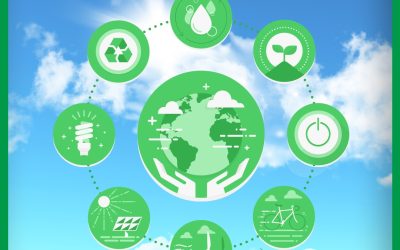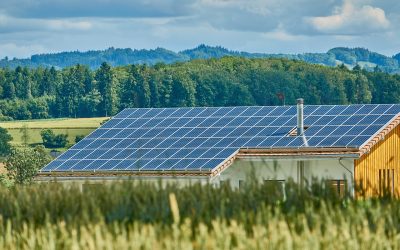You’ve probably heard about the harmful effects of air and water pollution, but did you know there are initiatives in place to tackle this global problem? In this article, we’ll explore the concept of reduced air and water pollution and how it impacts our environment and health. From innovative technologies to government regulations, we’ll delve into the various approaches being taken to combat pollution and create a healthier, cleaner world for future generations. So, let’s jump right in and uncover the fascinating world of reduced air and water pollution.

Causes of Air Pollution
Air pollution is primarily caused by a variety of factors that release harmful substances into the atmosphere. One significant cause of air pollution is industrial emissions. Industries, such as factories and power plants, emit large amounts of pollutants into the air, including sulfur dioxide, nitrogen oxides, and particulate matter. These pollutants contribute to smog and can have detrimental effects on both human health and the environment.
Another significant source of air pollution is vehicle emissions. The combustion of fossil fuels in vehicles releases pollutants such as carbon monoxide, nitrogen oxides, and volatile organic compounds into the air. This not only leads to poor air quality but also contributes to the formation of harmful ground-level ozone. The increasing number of vehicles on the road has resulted in a significant increase in air pollution in urban areas.
The burning of fossil fuels, such as coal, oil, and natural gas, is another major contributor to air pollution. These fossil fuels are widely used for electricity generation, heating, and transportation. When burned, they release pollutants such as carbon dioxide, sulfur dioxide, and mercury into the atmosphere. These pollutants contribute to global warming, acid rain, and other harmful environmental effects.
Agricultural activities also play a role in air pollution. The use of chemical fertilizers in crop production releases nitrogen compounds into the air, leading to the formation of smog and contributing to climate change. Additionally, livestock farming produces methane, a potent greenhouse gas that contributes to global warming. The improper management of agricultural waste, such as the burning of crop residues, further adds to air pollution.
Effects of Air Pollution
Air pollution has numerous adverse effects, both on human health and the environment. One of the most significant impacts is respiratory problems. Fine particulate matter and other pollutants present in the air can reach deep into the lungs, causing respiratory ailments such as asthma, bronchitis, and even lung cancer. Long-term exposure to air pollution can lead to chronic respiratory conditions and reduce overall lung function.
Climate change is another significant effect of air pollution. The release of greenhouse gases, such as carbon dioxide and methane, into the atmosphere contributes to the warming of the planet. This leads to a rise in global temperatures, resulting in melting ice caps, rising sea levels, and altered weather patterns. Extreme weather events, including hurricanes, heatwaves, and droughts, become more frequent and severe due to climate change.
Air pollution also disrupts ecosystems by affecting both plant and animal life. The deposition of pollutants, such as sulfur and nitrogen compounds, can lead to acid rain, which harms forests, lakes, and rivers. These pollutants can also damage plant leaves, reducing their productivity and affecting the entire food chain. The decline of certain plant species due to air pollution can disrupt ecosystems and threaten biodiversity.
Measures to Reduce Air Pollution
To mitigate the impact of air pollution, various measures can be implemented. One effective strategy is the use of clean energy sources. Transitioning from fossil fuels to renewable energy sources, such as solar, wind, and hydropower, can significantly reduce air pollution. These sources do not produce harmful emissions during electricity generation, thus improving air quality and reducing carbon emissions.
Improved transportation systems are also crucial in reducing air pollution. Promoting the use of public transportation, carpooling, and cycling can reduce vehicle emissions and congestion on roads. Investing in efficient and low-emission vehicles, such as electric cars, can further contribute to reducing air pollution. Additionally, the development of infrastructure for walking and cycling can encourage people to choose greener modes of transportation.
Industrial emission controls are vital in reducing air pollution from industrial sources. Implementing stricter regulations on emissions and requiring industries to adopt cleaner technologies can help curb pollution. Installing pollution control devices, such as scrubbers and filters, on industrial smokestacks can capture harmful pollutants before they are released into the atmosphere. Regular monitoring and enforcement of emission standards are also crucial to ensure compliance.
Raising awareness about air pollution and its effects is essential in promoting change. Through educational campaigns and public outreach, individuals can learn about the importance of reducing air pollution and make informed choices. Encouraging responsible behavior, such as reducing energy consumption, practicing proper waste management, and supporting sustainable practices, can go a long way in reducing air pollution.
Causes of Water Pollution
Water pollution is caused by various human activities that contaminate water bodies, making them unfit for use or harming the aquatic ecosystems that depend on them. One of the primary causes of water pollution is industrial waste discharge. Industries release untreated or inadequately treated wastewater into rivers, lakes, and oceans, carrying harmful chemicals, heavy metals, and other pollutants. This pollutes the water and poses a threat to both human health and marine life.
Sewage and wastewater discharge from domestic sources is another significant contributor to water pollution. Inadequate sewage treatment facilities and improper disposal practices lead to the release of pathogens, organic matter, and nutrients into water bodies. These contaminants can lead to the spread of waterborne diseases and the degradation of water quality.
The use of chemical fertilizers and pesticides in agriculture also contributes to water pollution. During rainfall or irrigation, these chemicals can be washed off from agricultural fields into nearby water sources. This contamination leads to eutrophication, where excessive nutrients cause algal blooms and deplete oxygen levels, harming aquatic life.
Oil spills present a severe threat to water quality and marine ecosystems. Accidental releases of oil from offshore drilling operations, tanker accidents, or illegal dumping can cause widespread pollution. The oil coats the surface of the water, suffocating marine organisms, and disrupting the delicate balance of marine ecosystems. Additionally, oil spills can contaminate water supplies, affecting human health and local economies.

Effects of Water Pollution
Water pollution has profound effects on both human health and the environment. One of the most significant impacts is the spread of waterborne diseases. Contaminated water sources provide a breeding ground for disease-causing pathogens such as bacteria, viruses, and parasites. Ingesting or coming into contact with this polluted water can lead to illnesses like diarrhea, dysentery, cholera, and typhoid.
Water pollution also has detrimental effects on aquatic ecosystems. The introduction of pollutants into water bodies can disrupt the balance of ecosystems and harm aquatic organisms. High nutrient levels from agricultural runoff and sewage discharge can cause excessive algal growth, leading to oxygen depletion in the water. This harms fish and other aquatic organisms, resulting in reduced biodiversity and, in extreme cases, mass fish die-offs.
The loss of biodiversity is another significant consequence of water pollution. Many aquatic species depend on clean and healthy water habitats for their survival. Pollution can destroy or degrade these habitats, reducing the availability of food, shelter, and breeding grounds for various species. The decline of certain aquatic species can disrupt the delicate balance of ecosystems and lead to further environmental imbalances.
Measures to Reduce Water Pollution
To address water pollution, various measures can be implemented to prevent further contamination and restore contaminated water bodies. Waste treatment and recycling play a crucial role in reducing water pollution. Implementing proper wastewater treatment facilities can remove harmful pollutants before the water is discharged back into the environment. Recycling wastewater for irrigation and industrial purposes can also reduce the strain on freshwater resources.
Strict regulation on waste disposal is essential to prevent water pollution. Establishing and enforcing stringent laws and regulations on the discharge of industrial waste and sewage can help minimize pollution. Industries and municipalities must comply with these regulations to ensure that their waste is adequately treated before being released into water bodies.
Promoting organic farming practices can significantly reduce water pollution from agricultural sources. Organic farming avoids the use of synthetic fertilizers and pesticides, thereby minimizing the contamination of water bodies. Organic farming techniques focus on maintaining soil health and using natural methods to control pests and diseases, resulting in healthier ecosystems and improved water quality.
To prevent oil spills, preventive strategies need to be implemented. Strict regulations on offshore drilling operations and oil transportation should be enforced to ensure proper maintenance of equipment and adherence to safety protocols. Regular inspections and monitoring of oil rigs and tankers can help identify potential risks and prevent accidents. Additionally, promoting the development and use of alternative and renewable energy sources can reduce the demand for fossil fuels, lessening the likelihood of oil spills.

Impact of Reduced Air Pollution on Health
Reducing air pollution can have significant positive impacts on human health. One of the most noticeable improvements is in respiratory health. With cleaner air, the incidence of respiratory problems such as asthma attacks, bronchitis, and chronic obstructive pulmonary disease (COPD) can be reduced. Cleaner air means less exposure to particulate matter, allergens, and other pollutants that can irritate the lungs and exacerbate respiratory conditions.
A reduction in air pollution also leads to a lowered risk of cardiovascular diseases. Studies have shown a strong association between air pollution and heart conditions such as heart attacks, strokes, and hypertension. By minimizing exposure to air pollutants, the risk of these cardiovascular diseases can be mitigated, leading to improved heart health and overall well-being.
Air pollution is closely linked to the frequency and severity of respiratory infections. Pollutants in the air can weaken the respiratory system, making individuals more susceptible to respiratory infections such as the common cold, influenza, and pneumonia. By reducing air pollution, the likelihood of contracting these infections decreases, resulting in fewer cases of illness and improved overall respiratory health.
Impact of Reduced Air Pollution on Climate
Reducing air pollution has far-reaching benefits for the climate and the environment. One of the most significant impacts is the slowing down of global warming. By curbing the emissions of greenhouse gases, such as carbon dioxide and methane, the rate of temperature rise can be slowed. This helps mitigate the adverse effects of climate change, such as rising sea levels, more intense heatwaves, and the loss of polar ice.
The mitigation of extreme weather events is another crucial impact of reducing air pollution. Climate change amplifies the frequency and intensity of extreme weather events, including hurricanes, droughts, and heatwaves. By reducing greenhouse gas emissions, the severity of these events can be reduced, providing significant relief to communities vulnerable to the impacts of such events.
Reducing air pollution also contributes to the protection of the ozone layer. Certain air pollutants, such as chlorofluorocarbons (CFCs), contribute to the depletion of the ozone layer in the Earth’s stratosphere. The ozone layer acts as a shield, protecting life on Earth from harmful ultraviolet (UV) radiation. By reducing the release of these ozone-depleting substances, the recovery and preservation of the ozone layer can be facilitated.
Impact of Reduced Air Pollution on Ecosystems
The reduction of air pollution has substantial benefits for ecosystems and the wildlife that depends on them. One of the significant impacts is the preservation of biodiversity. Air pollution can have detrimental effects on plant species, reducing their productivity and leading to declines in populations. This, in turn, disrupts the food chain, affecting animals that depend on these plants for food and shelter. By reducing air pollution, the overall health and vitality of ecosystems can be maintained, preserving biodiversity.
Improved air quality resulting from reduced air pollution also benefits flora and fauna directly. Plants require clean air for photosynthesis, the process by which they create food. By reducing the presence of pollutants such as sulfur and nitrogen compounds in the air, the health and growth of plants can be enhanced. This, in turn, provides a healthier habitat for animals that depend on these plants for food and shelter.
The reduction of air pollution leads to a decrease in the occurrence of acid rain. Acid rain is formed when pollutants such as sulfur dioxide and nitrogen oxides react with atmospheric moisture, leading to a decrease in pH levels of rainfall. Acid rain has detrimental effects on forests, lakes, and rivers, damaging plant and animal life. By reducing air pollution, the occurrence of acid rain is minimized, leading to healthier ecosystems and improved water quality.
Impact of Reduced Water Pollution on Aquatic Life
Efforts to reduce water pollution can have significant positive impacts on aquatic life and the overall health of aquatic ecosystems. One of the critical impacts is the restoration of aquatic habitats. Reducing pollution levels in rivers, lakes, and oceans allows for the recovery of degraded habitats. This restoration provides better living conditions for aquatic species, promoting their survival and overall well-being.
Reducing water pollution also contributes to boosting marine biodiversity. Many marine organisms rely on clean water for their survival and reproduction. By minimizing pollution, the availability of suitable habitat and food sources for these organisms increases. This, in turn, leads to the proliferation of diverse species and the preservation of delicate marine ecosystems.
Improved water quality resulting from reduced pollution has a direct impact on fish populations. Clean and healthy water bodies support the growth and reproduction of fish species. By reducing pollution, the water quality improves, providing a better environment for fish to thrive. This leads to increased fish populations, benefiting both commercial and recreational fishing industries and ensuring the sustainability of fish stocks.
In conclusion, the causes and effects of both air and water pollution are widespread and significant. Industrial emissions, vehicle emissions, burning of fossil fuels, and agricultural activities are the primary causes of air pollution. These lead to respiratory problems, climate change, and ecosystem disruption. On the other hand, industrial waste discharge, sewage and wastewater discharge, chemical fertilizers and pesticides, and oil spills are the main causes of water pollution. Water pollution results in waterborne diseases, damage to aquatic ecosystems, and loss of biodiversity.
To tackle air pollution, measures such as the use of clean energy sources, improved transportation systems, industrial emission controls, and awareness campaigns are crucial. Similarly, for water pollution, waste treatment and recycling, strict regulation on waste disposal, promotion of organic farming, and oil spill prevention strategies need to be implemented.
The impacts of reducing air pollution include improved respiratory health, reduced risks of cardiovascular diseases, and a lower incidence of respiratory infections. It also helps slow down global warming, mitigates extreme weather events, and protects the ozone layer. On the other hand, reduced water pollution leads to the restoration of aquatic habitats, boosting marine biodiversity, and improved fish populations.
By understanding the causes and effects of air and water pollution and implementing effective measures to reduce them, we can strive towards a cleaner and healthier environment for ourselves and future generations.










